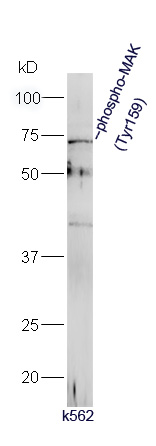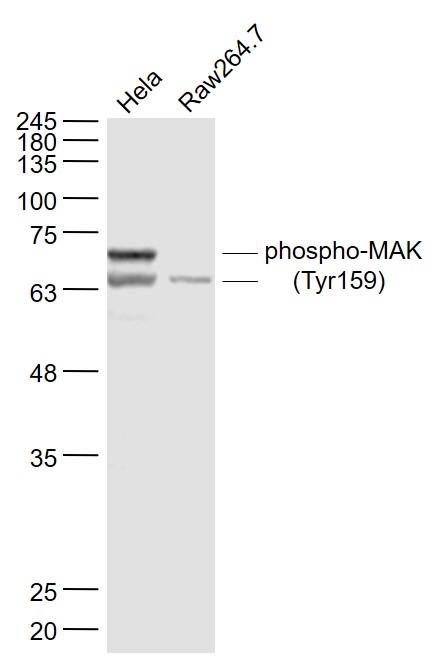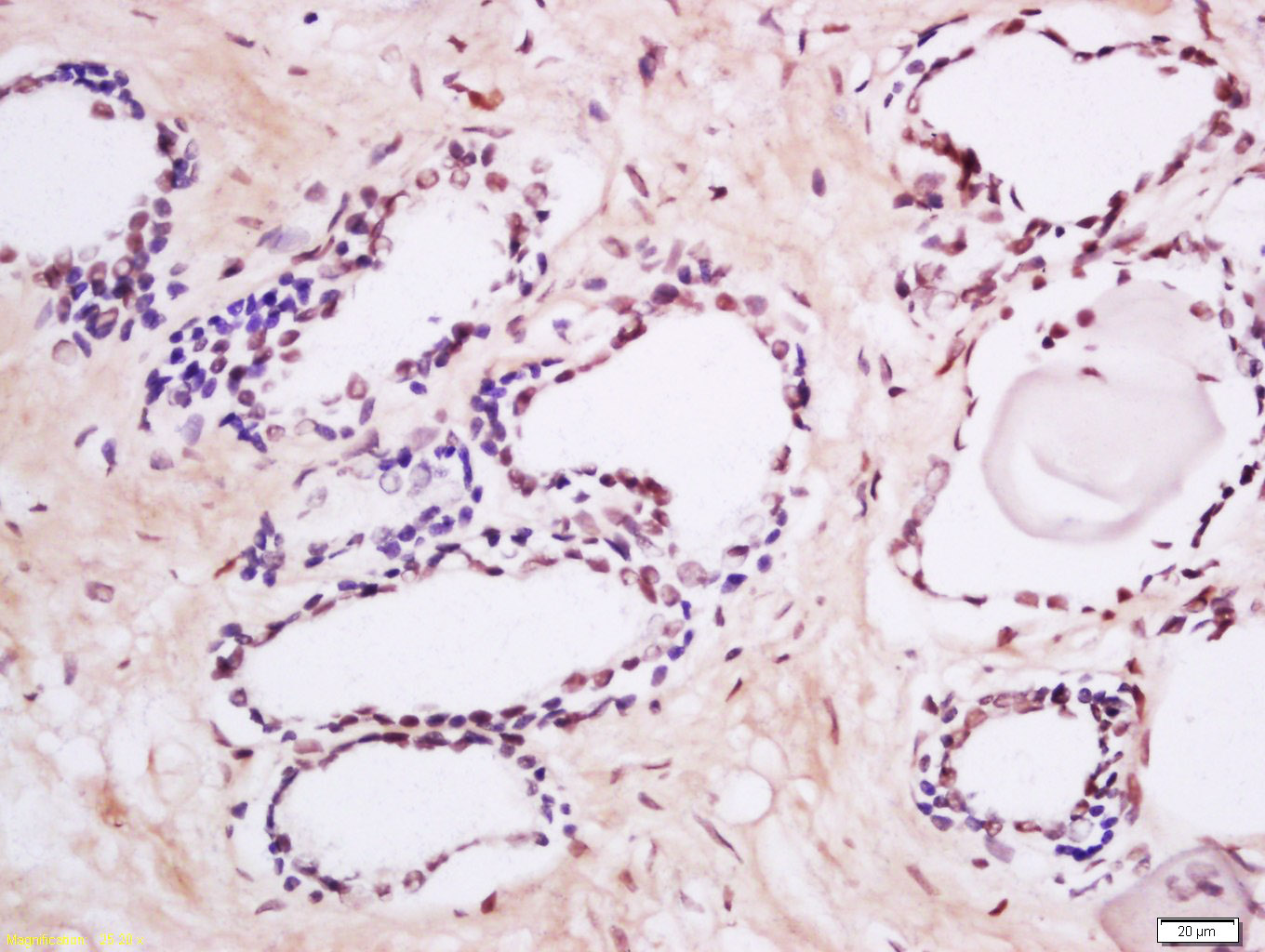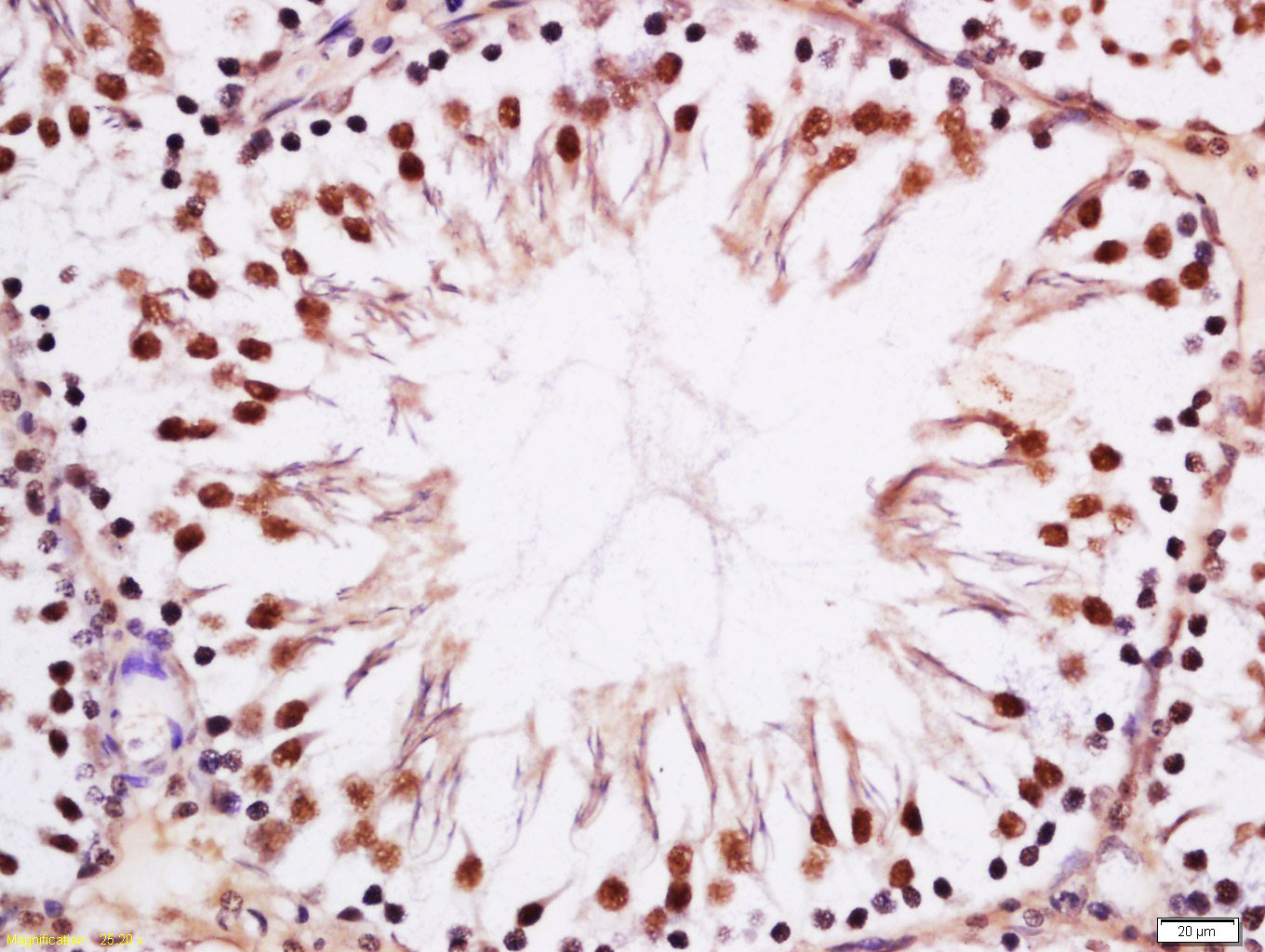
Rabbit Anti-phospho-MAK (Tyr159)antibody
MAK (phospho Tyr159); MAK (phospho Y159); dJ417M14.2; Mak; MAK_HUMAN; Male germ cell associated kinase; Male germ cell-associated kinase; OTTHUMP00000016025; Rck; Serine/threonine protein kinase MAK; Serine/threonine-protein kinase MAK.
View History [Clear]
Details
Product Name phospho-MAK (Tyr159) Chinese Name 磷酸化丝氨酸/苏氨酸蛋白激酶MAK抗体 Alias MAK (phospho Tyr159); MAK (phospho Y159); dJ417M14.2; Mak; MAK_HUMAN; Male germ cell associated kinase; Male germ cell-associated kinase; OTTHUMP00000016025; Rck; Serine/threonine protein kinase MAK; Serine/threonine-protein kinase MAK. Product Type Phosphorylated anti Research Area Cell biology Developmental biology Signal transduction Kinases and Phosphatases Immunogen Species Rabbit Clonality Polyclonal React Species Human, Mouse, Rat, Applications WB=1:500-2000 ELISA=1:5000-10000 IHC-P=1:100-500 IHC-F=1:100-500 ICC=1:100-500 IF=1:100-500 (Paraffin sections need antigen repair)
not yet tested in other applications.
optimal dilutions/concentrations should be determined by the end user.Theoretical molecular weight 71kDa Cellular localization The nucleus cytoplasmic Form Liquid Concentration 1mg/ml immunogen KLH conjugated synthesised phosphopeptide derived from human MAK around the phosphorylation site of Tyr159: TD(p-Y)VS Lsotype IgG Purification affinity purified by Protein A Buffer Solution 0.01M TBS(pH7.4) with 1% BSA, 0.03% Proclin300 and 50% Glycerol. Storage Shipped at 4℃. Store at -20 °C for one year. Avoid repeated freeze/thaw cycles. Attention This product as supplied is intended for research use only, not for use in human, therapeutic or diagnostic applications. PubMed PubMed Product Detail The product of this gene is a serine/threonine protein kinase related to kinases involved in cell cycle regulation. It is expressed almost exclusively in the testis, primarily in germ cells. Studies of the mouse and rat homologs have localized the kinase to the chromosomes during meiosis in spermatogenesis, specifically to the synaptonemal complex that exists while homologous chromosomes are paired. There is, however, a study of the mouse homolog that has identified high levels of expression in developing sensory epithelia so its function may be more generalized. Three transcript variants encoding different isoforms have been found for this gene. [provided by RefSeq, Jul 2011]
Function:
Essential for the regulation of ciliary length and required for the long-term survival of photoreceptors (By similarity). Phosphorylates FZR1 in a cell cycle-dependent manner. Plays a role in the transcriptional coactivation of AR. Could play an important function in spermatogenesis.
May play a role in chromosomal stability in prostate cancer cells.
Subcellular Location:
Nucleus. Cytoplasm > cytoskeleton > centrosome. Cytoplasm > cytoskeleton > spindle. Midbody. Cell projection > cilium > photoreceptor outer segment. Photoreceptor inner segment. Localized in both the connecting cilia and the outer segment axonemes (By similarity). Localized uniformly in nuclei during interphase, to the mitotic spindle and centrosomes during metaphase and anaphase, and also to midbody at anaphase until telophase.
Tissue Specificity:
Expressed in prostate cancer cell lines at generally higher levels than in normal prostate epithelial cell lines. Isoform 1 is expressed in kidney, testis, lung, trachea, and retina. Isoform 2 is retina-specific where it is expressed in rod and cone photoreceptors.
Post-translational modifications:
Autophosphorylated. Phosphorylated on serine and threonine residues.
DISEASE:
Defects in MAK are the cause of retinitis pigmentosa type 62 (RP62) [MIM:614181]. RP62 is a retinal dystrophy belonging to the group of pigmentary retinopathies. Retinitis pigmentosa is characterized by retinal pigment deposits visible on fundus examination and primary loss of rod photoreceptor cells followed by secondary loss of cone photoreceptors. Patients typically have night vision blindness and loss of midperipheral visual field. As their condition progresses, they lose their far peripheral visual field and eventually central vision as well.
Similarity:
Belongs to the protein kinase superfamily.
CMGC Ser/Thr protein kinase family.
CDC2/CDKX subfamily. Contains 1 protein kinase domain.
SWISS:
P20794
Gene ID:
4117
Database links:Entrez Gene: 4117 Human
Entrez Gene: 17152 Mouse
Omim: 154235 Human
SwissProt: P20794 Human
SwissProt: Q04859 Mouse
Unigene: 446125 Human
Unigene: 8149 Mouse
Unigene: 9670 Rat
Product Picture
Primary: rabbit Anti-phospho-MAK (Tyr159) (SL18634R) at 1:300;
Secondary: HRP conjugated Goat-Anti-rabbit IgG(SL0295G-HRP) at 1: 5000;
Predicted band size: 71 kD
Observed band size: 71 kDSample:
Raw264.7(Mouse) Cell Lysate at 30 ug
Primary: Anti- phospho-MAK (Tyr159) (SL18634R) at 1/1000 dilution
Secondary: IRDye800CW Goat Anti-Rabbit IgG at 1/20000 dilution
Predicted band size: 71 kD
Observed band size: 73 kD
Sample:
Hela(Human) Cell Lysate at 30 ug
Raw264.7(Mouse) Cell Lysate at 30 ug
Primary: Anti- phospho-MAK (Tyr159) (SL18634R) at 1/1000 dilution
Secondary: IRDye800CW Goat Anti-Rabbit IgG at 1/20000 dilution
Predicted band size: 71 kD
Observed band size: 71/66 kD
Tissue/cell: human prostate tissue; 4% Paraformaldehyde-fixed and paraffin-embedded;
Antigen retrieval: citrate buffer ( 0.01M, pH 6.0 ), Boiling bathing for 15min; Block endogenous peroxidase by 3% Hydrogen peroxide for 30min; Blocking buffer (normal goat serum,C-0005) at 37℃ for 20 min;
Incubation: Anti-phospho-MAK (Tyr159) Polyclonal Antibody, Unconjugated(SL18634R) 1:200, overnight at 4°C, followed by conjugation to the secondary antibody(SP-0023) and DAB(C-0010) staining
Tissue/cell: rat testis tissue; 4% Paraformaldehyde-fixed and paraffin-embedded;
Antigen retrieval: citrate buffer ( 0.01M, pH 6.0 ), Boiling bathing for 15min; Block endogenous peroxidase by 3% Hydrogen peroxide for 30min; Blocking buffer (normal goat serum,C-0005) at 37℃ for 20 min;
Incubation: Anti-phospho-MAK (Tyr159) Polyclonal Antibody, Unconjugated(SL18634R) 1:200, overnight at 4°C, followed by conjugation to the secondary antibody(SP-0023) and DAB(C-0010) staining
Bought notes(bought amounts latest0)
No one bought this product
User Comment(Total0User Comment Num)
- No comment







 +86 571 56623320
+86 571 56623320
 +86 18668110335
+86 18668110335

